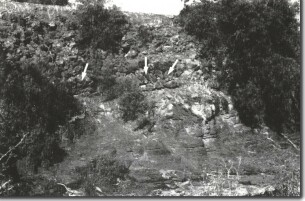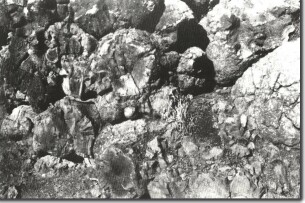Me3 Toolern Creek, Exford - Pillow Lava
|
This information has been developed from the publications:
|
| Location | Melton - 965193. Shire of Melton. Cliff sections along Toolern Creek 100 m to 500 m upstream from the bridge of Greig Road. |  Me3 - Several flows exposed in valley of Toolern Creek, Exford. Pillow lavas arrowed. |
Access | Exford Road and Greig Road. | |
Ownership | Private land. | |
Site Description | Cliffs along the river upstream from the bridge, expose flows of basalt, tuff and agglomerate of the Exford Volcanics. Thin sediments including gravels occur between the flows. At the cliff approximately 500 m upstream there are three distinct flows revealed. At stream level, the upper 4 m of a dark, hard, non-vesicular basalt flow is overlain by a thin and variable layer of weathered tuff and gravel. Resting above this layer is a 15 m thick augite basalt flow, the base of which displays well-formed pillow lavas. Pillow lavas are rounded or elongated structures in a lava flow often with glassy margins and radial cracking. They develop when fluid lava enters a body of water (lake or stream) and the mobile rock breaks into elongated or ellipsoidal bodies that solidify into roughly conformable shapes that in cross section look like a stack of pillows. In this case, the lava probably entered a small lake formed during damming of a stream by earlier flows. The pillow lavas at Exford average 40 to 50 cm in diameter with a 3 to 4 cm glassy skin. | |
Significance | National. This is an outstanding example of a pillow lava. It is displayed in the environment of its formation as the sediments and gravels of the stream and lake beds are exposed immediately below the lowest pillows. They appear to be the most authentic pillow lavas in all the Newer Volcanic rocks in Victoria and are some of the best examples known in Australia. They are very well preserved and very clearly displayed. |  Me3 - Details of pillow lavas, Exford. |
Management | Class 1. The site has little general public interest but is of considerable scientific and educational importance. The pillows are relatively fragile and can be easily damaged by unsupervised examination and collection of the glassy outer skin. Private land ownership has been the main factor in retaining the exposures intact as is and reducing public pressure on the site. The site could be retained in this status although it will be necessary to advise the land owner that no construction work, quarrying or activity that would damage or cover the exposure would be permitted. Alternatively, the area of the site could be purchased or leased from the owner. | |
A secure pathway to the base of the site could be developed across the private land to allow access to authorized groups. Some vegetation clearing from the main cliff would improve the general views of the pillow sections. No material should be removed from the pillows unless in very small amounts and for genuine research purposes. | ||
References | Condon, M.A. (1951). The Geology of The Lower Werribee River, Victoria. Proc. R. Soc. Vict. 63:1-24. Joyce, E.B. and King, R.L. (1980). | |


